The study of level crossing safety in Finland
Posted: 28 May 2008 | | No comments yet
In Finland, railway undertaker VR and Finnish Rail Administration (RHK) became concerned in 2005 about the high number of level crossing accidents. VR sent a letter to the Accident Investigation Board of Finland (AIBF) and asked for it to take action to prevent level crossing accidents. They had noticed that the level of railway safety […]
In Finland, railway undertaker VR and Finnish Rail Administration (RHK) became concerned in 2005 about the high number of level crossing accidents. VR sent a letter to the Accident Investigation Board of Finland (AIBF) and asked for it to take action to prevent level crossing accidents. They had noticed that the level of railway safety in Finland was high in international comparison, but safety on level crossings was considered much worse. At the same time, the amount of other rail accidents had decreased but the amount of level crossing accidents was shown to have increased.
At that time, AIBF didn’t investigate level crossing accidents, except those accidents in which a train had derailed or a passenger or a train crew member was deceased or injured seriously. Level crossing accidents were counted as road accidents. Fatal road accidents were investigated by the Traffic Accident Investigation Teams of the Traffic Safety Commission of Finnish Motor Insurers’ Centre (VALT). Minor accidents were investigated only by the operator and/or the police.
So, AIBF decided to make a safety study on these findings. AIBF nominated a commission with an investigator-in-charge (me) and eight members. A decision was made that the commission should study documents produced by VALT and documentation collected by VR on level crossing accidents between 2003 and 2005 and to investigate five-ten new level crossing accidents of different types and different scopes.
In 2004, there was 5,741km of track and 4,510 level crossings on the Finish network. 744 level crossings were equipped with half barriers, 104 were equipped with light and sound warning systems and 3,662 were unprotected.
Level crossing safety in an international perspective
The commission had to first clarify what the situation was internationally. It was very hard work to find comparable statistics from different countries. The commission had to choose just some countries, but in the end decided upon Norway, Switzerland, USA, Canada, Australia and New Zealand. However, we had to drop New Zealand off the list, because not enough data was available. The countries chosen were done so because they had a lot of railway traffic and they had also independent accident investigation. Data was collected on railways, roads, level crossings, railway traffic, road traffic, rail and road accidents and different kinds of data of level crossing accidents. The latest year from which we could have enough data was 2004. Certain countries provided data on level crossing accidents from 1991 to 2005. Calculations and diagrams were made based on statistics (see Figures 1–3).
Level crossing accidents in Finland
The level crossing accident statistics showed that the situation in Finland was not too good. We tried to find out why the situation in some other countries was better than in Finland.
At the same time, we studied statistics and other facts of level crossing accidents in Finland since 1991 and investigated six new level crossing accidents. Two were fatal.
The VALT documentation of fatal road accidents included statistics which was useful in comparing fatal level crossing accidents with other fatal road accidents. We found out, for example, from comparisons of causes (see Figure 4) and other facts which existed in level crossing accidents (see Figure 5 and 6).
As a summary of all fatal level crossing accidents investigated by VALT, it should be noted that several factors were simultaneously at the background of an accident. Their combined effect made the accident possible. Ultimately, the driver of the vehicle made a crucial mistake (e.g. did not observe, continued without stopping), but the chain of events nevertheless began much earlier. Most of the accidents took place at unprotected level crossings. In such crossings, responsibility for the safe crossing has been left solely to the driver.
From the statistics and other documentation of VR and RHK, we found out that of the 818 accidents that occurred over the period between 1991 and 2004, most cases (78%) took place at unprotected level crossings. Approximately 106 accidents (13%) occurred at half barrier level crossings, while 74 accidents (9%) occurred at crossings with light and sound warning systems. Of the total level crossings in place over the review period, an average of 79.7% were unprotected, 17.8% had half-barrier and 2.5% were equipped with light and sound warning systems. Therefore, there were proportionally more accidents at level crossings with light and sound warning signals than at half-barrier level crossings.
In Finland, the highest ratio of accidents occurs at unprotected level crossings. In other countries, including those with a high number of level crossing accidents, accidents are more common at protected level crossings. It is likely that such crossings also have heavy traffic. Finland’s level crossings and level crossing accidents are distributed over a wide area, which is natural for a sparsely populated country. Most of the unprotected level crossings are situated in countryside on private owned village roads and farm roads.
From the new seven accidents that we investigated, we found out the main facts that they occurred at a level crossing familiar to the driver. In five cases, the level crossing was unprotected (in four cases equipped with STOP signs). In one case, it was equipped with light and sound warning installation and in one with half-barriers. In all cases, the car drove to the crossing without stopping. The driver either failed to observe the train or observed it too late. And we also noticed that it depends on luck whether the level crossing accident leads to death or to no injuries.
The commission considered that the basis for improving level crossing safety should be the removal of level crossings. In the long-term, the number of level crossings should be reduced following an established plan of authorities. Safety should be the most important factor.
The main recommendation of the commission is that stopping before the level crossing should be adopted as the regular model of behaviour at unprotected level crossings in which the sightline along the railway isn’t attained earlier than at a distance of 8 meters from the track. The implementation of this could be promoted by:
- Inventorying level crossings to identify on which the sightline towards the railway isn’t attained earlier than at distance of 8 meters from the railway and installing STOP signs before the crossing
- Designing and carrying out the road profile in terms of its wait platform so as to prevent any risk of jamming in any instance
- Informing and trying to pay drivers’ attention to the great importance of stopping at a level crossing and that the safe sightline is generally attained not earlier than at distance of 8 meters from the railway
- Paying much more attention to behaviour at level crossing in basic and advance driver training
- Increasing the monitoring of level crossings, possibly including camera surveillance.
The implementation of these measures requires cooperation among all parties involved (rail operators, infrastructure managers, road keepers, communities, etc.)
The commission made nine other recommendations and reiterated three recommendations made earlier to improve the level crossing safety.
The original safety study (summary, foreword, tables on accidents, as well as the legends for the images, charts and tables in English) and the shortened versions (in Finnish, Swedish and English), can be found on the Internet home pages of AIBF at the address www.onnettomuustutkinta.fi
Development of level crossing safety
The Safety Study commenced in December 2005 and it was published in June 2007. It is too early to estimate the influence of it to the level crossing safety. 2007 was however quite black in level crossing safety in Finland. Seven fatal accidents (10 fatalities) occurred in 2007, more than many previous years, but the total amount of level crossing accidents was less than in previous years (Figures 8 and 9).
Campaigns to improve level crossing safety
In Spring 2007, the Finnish Rail Administration together with the Finnish Rail Agency, VR-Group Ltd, the Ministry of Transport and Communications, the Central Organisation for Traffic Safety in Finland (Liikenneturva), the Road Administration and the Police started a campaign for level crossing safety. In the campaign, they emphasise the dangers for car drivers and other road users about level crossings.
Also, AIBF tries to inform people about the behaviour on level crossings and about the dangers included. We have widely distributed both the shortened version of the Safety Study on Level Crossing Accidents and the DVD “Be careful on Level Crossing”, for example, to all driving schools, communities and road districts in Finland. We have also investigated all fatal level crossing accidents involving road vehicles since the beginning of 2007. We have arranged a meeting for all parties involved to discuss about the actions to increase safety on one particular section of railway line.
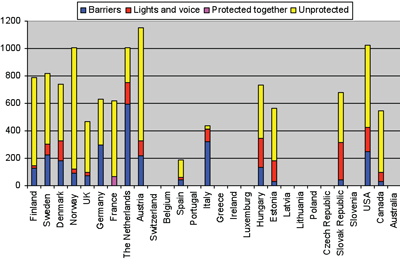

Figure 1: Level crossings per 1,000 km of track in 2004
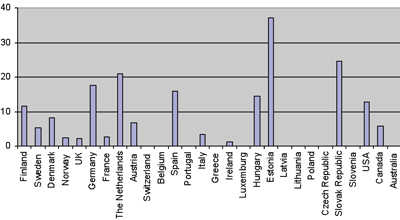

Figure 2: Level crossing accidents per 1,000 level crossings in 2004


Figure 3: The number of level crossing accidents in Finland, other Nordic countries, UK and Canada in 1991-2005
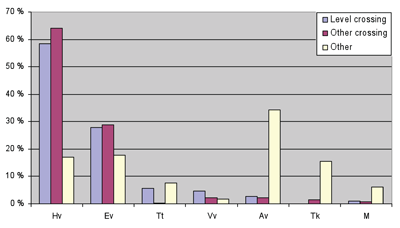

Figure 4: Immediate risk factor for card driver in fatal level crossing, other crossing and other traffic accidents in Finland 1991-2004. In diagram, Hv = observation error, Ev = anticipation and assessment error, Tt = knowingly running into the situation, Vv = driving with disregard for the hazard, Av = errors in road vahicle handling, Tk = change in capacity to act, M = other
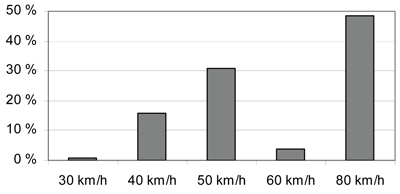

Figure 5: The speed limit on road in fatal level crossing accidents in Finland 1991 - 2004


Figure 6: Eveness of road in fatal level crossing accidents in Finland 1991 - 2004
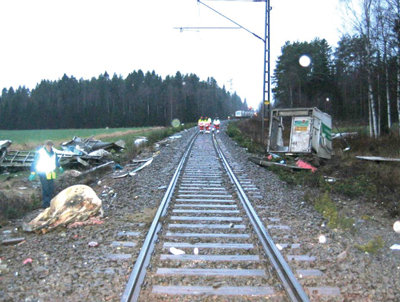

Figure 7: The worst of the accidents observed by the Commission occured at an unprotected level crossing in Kalvia, where a pendaline train , at a speed of 140 km/h, colided with a lorry carrying livestock
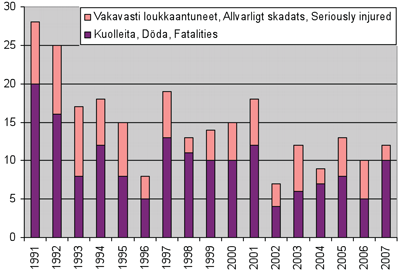

Figure 8: Seriously injured and fatalities in Finland 1991 - 2007








